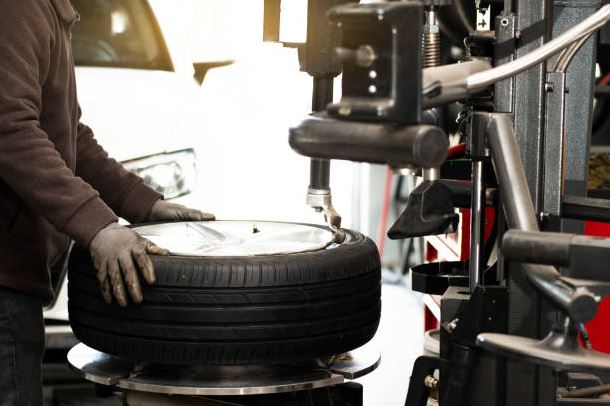Generally speaking, you can identify a run-flat tire by observing the information printed on the sidewall. Sadly, there is no industry standard initial to represent this. Instead, different manufacturers use symbols or letters to distinguish their Run-Flat from other models.
Michelin manufactures tires with Run-Flat technology, among other models. The French company prints the letters “ZP” on the sidewall of their tires to signify that they are run flat. So, the best way to tell if your Michelin tires are run-flat is to confirm if the “ZP” symbol is printed on the tire’s sidewall.
The ZP initials stand for “Zero Pressure.” This underscores the tire’s ability to continue performing even in the event of a puncture or sudden loss of pressure, but for a limited period.
Meanwhile, if you check the sidewall of your Michelin tire and find “EMT” instead of “ZP,” the tire still has run-flat technology. On some of its run-flat models, Michelin uses the EMT symbol too. It stands for “Extended Mobility Tyres.”
Table of Contents
How Does Michelin Run-Flat Tires Work?
Like the run-flat design of most other brands, Michelin ZP tires are equipped with reinforced sidewalls that allow them to continue working even if there is a leak in the tire.
When you are driving with these special tires and run over a protruding object that punctures the tire, air starts to leak out, but the reinforced sidewall will prevent the tire from going completely flat.
After a puncture, the shape of the ZP tire may not remain the same, but it will be in the right shape to allow you to drive for a period so you can get to the nearest garage (as opposed to quickly parking in the middle of nowhere when using traditional tires)
The run-flat indicator on your car will alert you when there is a puncture. But after replacing the tire, you will need to reset the tire pressure warning light using the pressure warning button beside the handbrake of your vehicle.
How Long Can You Drive on Punctured Michelin Run-Flat Tires?
Run-flat tires have varying distances; they can function after a puncture and operate at varying speeds. This is where the line is drawn as to which brand is superior -similar to Pirelli’s RSC tires.
When using Michelin ZP tires, you could call this a tradeoff, especially compared to the 80 km/h for Continental’s SSR tires.
But it has a general design that run-flat tires allow you to drive for a limited distance at a reduced speed after a puncture to prevent complete loss of inflation pressure.
Can Michelin Run-Flat Tire Be Repaired?
According to Michelin tire manufacturers, the reparability of their ZP run-flat tires depends on some factors. Tire repair is usually possible if the puncture is in the tread area. (The puncture mustn’t be too large)
If the damage is done in the shoulder area or the sidewall, a repair is not possible, and the tire must be replaced because there is a high risk that the puncture will weaken or damage the overall structure.
However, a few other cases determine whether a Michelin ZP tire is repairable or not, and the company has spelled out all the conditions HERE.
Can I Mount My Michelin Run- Flat Tires on Any Vehicle?
Unfortunately, Michelin Run Flat tires will not fit every vehicle, and the same is true for other brands’ run flats.
The vehicle suitable for these special tires must have some suspension and chassis modifications integrated for run-flat tires.
Difference between ZP and ZR on Michelin Tires
The initials ZR should not be confused with the initials ZP. You may find the ZR letters on the sidewall of Michelin tires, but it has nothing to do with run-flat technology.
ZR relates to the tire’s speed rating, which means the tire shouldn’t be driven at a speed greater than 240 mph or 150mph.
Most tires will have their speed rating code printed on the sidewall, among other salient information. But unlike Run Flats information, speed rating codes are universal, hence used by all manufacturers the same way.
Downsides to Michelin Run-Flat Tires
When it comes down to overall quality, Michelin run-flats are better than its conventional models. However, it comes at a price. Some tradeoffs include affordability, ride quality, fuel economy, and reparability.
Michelin uses special rubber compounds in producing their ZP models, which explains why they cost more. Also, the technology behind this feature makes the sidewall of the ZP tires stronger than the usual models. But there is the risk of flexibility, which could take a toll on driving comfort.
Aside from these considerations, Michelin Run Flat tires do not accept replacement tires. However, in the event of damage, you may replace the whole set of run-flat tires, depending on the damage situation.
Finally
Michelin is among the top tire manufacturers that produce tires with Run-Flat technology. They differentiate these special models from other variations by printing ZP on the sidewall for easier recognition.
Products like the. Michelin Pilot Sport 4 ZP, Michelin Primacy 3 ZP, and Michelin Pilot Super Sport ZP are good examples of French company run-flat tires.
While the Super Sport ZP is developed with high-end cars like Porsche, BMW, and Ferrari, the Primacy 3 ZP features a new patented compound with a special tread pattern for shorter braking distances.

